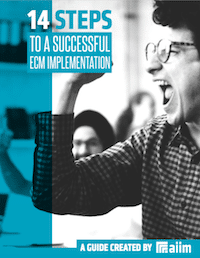The AIIM Blog
Keep your finger on the pulse of Intelligent Information Management with industry news, trends, and best practices.
If you’ve been paying attention to the research we conduct and the educational information we share, you know that AIIM describes Intelligent Information Management (IIM) as all the things you want to do with, or get from, your organization’s information. We break these up into five key categories of actions or aspirations: Creating and Capturing Information Extracting Intelligence from Information Digitalizing Core Business Processes Automating Governance and Compliance Implementing an Information Management Solution
Share
There are still many organizations that could benefit from the adoption of process automation technologies like Business Process Management (BPM), Robotic Process Automation (RPA), and Case Management. In fact, according to AIIM research, the overall adoption of these technologies is around 30-40% of organizations, skewed toward larger organizations with more than 1,000 employees. That leaves roughly 60-70% of organizations that make up potential users. To help these potential users, we surveyed experienced users of BPM, RPA, and/or Case Management technologies for their best advice for getting started.
Share

Making an ECM implementation successful requires planning and attention to detail. The best way to create the right solution is to identify organizational goals and priorities. Learn how to manage a successful implementation in our free guide.
The volume, velocity, and variety of information that most organizations need to manage, store, and protect now exceeds their ability to even marginally keep pace manually. This rising tide of information requires thoughtful strategies for automation to leverage its true power. To see what really drives the push to automation, AIIM surveyed over 260+ information professionals (click here to get a Free copy of the report). Here’s a look at why the AIIM Community cares about process automation.
Share
AIIM on Air | Artificial Intelligence (AI)
The notion of Artificial Intelligence has pervaded both the business world and popular culture. And, while Hollywood often portrays AI in a future world of smart robots with super-human characteristics, the truth is that AI technologies are already at work fueling important changes in the way business is conducted every day.
Share
In last week's article, we talked about the changing role of M365 within organizations, how it is governed, and how it connects with other content management solutions. Given its rapid evolution and adoption – particularly with the maturation of Office 365 and Cloud versions of SharePoint, we probably should have made a few points about brand terminology. With similar names, "Microsoft 365" and "Office 365" are sometimes used synonymously by users. They are actually different. What's the difference? Let's take a look: The confusion may have started in 2017 with Microsoft's release of Microsoft 365. This new offering bundled a group of their existing products under one license. One of the products included in the bundle is Office 365...you can see where terminology confusion set in. Let's clear things up with the infographic below:
Share
As late as 2010, many end-users and solution providers viewed SharePoint as useful for project groups and document sharing – but more of an interesting tangent to the world of content management than “real” ECM. However, standalone ECM solutions at that time came at a very high cost. Many of these ECM solutions were built for high-volume scanning/capture applications and priced accordingly. So what about those who couldn't afford that investment? What about the middle market masses?
Share